Late Summer Colour with Herbaceous Perennials
Something to brighten the late summer garden - keeping the garden colourful & interesting into the autumn.
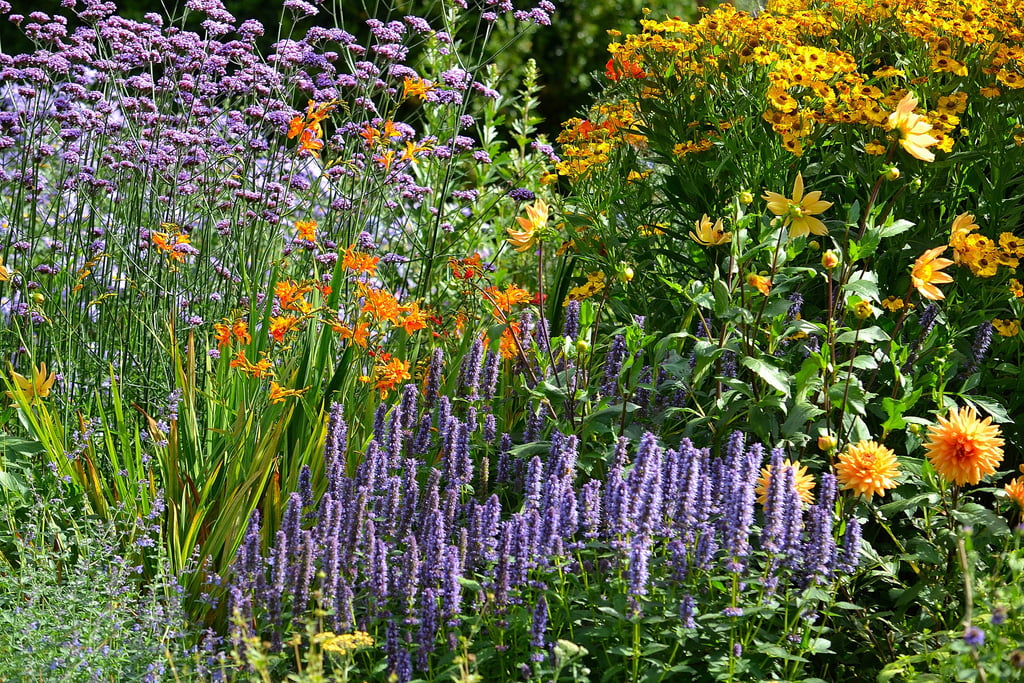

As the summer draws to a close, what we all need is a bit of colour in the garden to keep us going through the shortening days. All the plants mentioned here are easy to grow herbaceous perennials and have a long flowering period, they should provide colour and interest from late summer through to the autumn.
Japanese Anemone
Japanese Anemones are a robust stalwart of the late summer border that flower dependably from August to October. With their large long-lasting flowers coming in white, pink or mauve.
Penstemon
Penstemons are a useful addition to the border providing reliable flowering from mid-summer through to mid-autumn. They bring welcome colour to the garden, sitting well in the middle of the border. They can be used in a range of garden styles, from a traditional cottage garden to more contemporary areas.
Helenium - (Sneezeweed)
Heleniums bring warm vibrant colour to the garden, with their daisy-like flowers ranging from yellow, orange and red, appearing from mid-summer through to the autumn. These easy to grow sun-loving perennials are both tough and hardy
Aster × frikartii 'Mönch' AGM
These Aster hybrids are clump-forming, vigorous perennials growing up to 75cm. They have dark green foliage and strong, branching stems. From late summer to early autumn, they bear loose clusters of long-lasting, 5cm, lilac-blue, daisy like flowers with yellow/orange centres.
Hylotelephium spectabile (syn. sedum) Ice plant
These plants are adapted to deal with drought conditions. Flowering in autumn they provide a valuable nectar source for butterflies and other pollinating insects. The seed heads add contrasting deep tones among the muted colours of winter.
Japanese Anemones are vigorous, upright perennials up to 1.2m tall. The semi-double 9cm flowers are held on wiry branched stems. They are can be deciduous or semi evergreen depending upon their growing conditions.
Plant them in sun or partial shade, they can survive exposed or sheltered sites. They are ok in most soil types providing it’s not too dry and it doesn’t become waterlogged in winter (the mythical ‘moist but well drained’). They aren’t fussy about soil ph. The flowers appear on stiff stems that shouldn’t need staking.
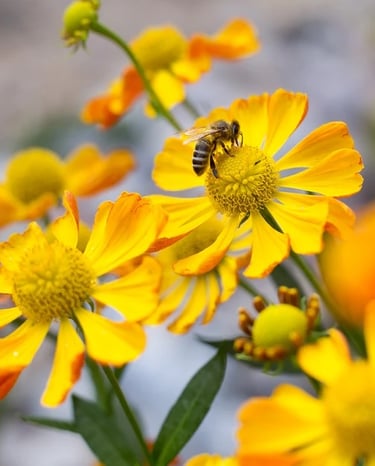

A late summer display at Coton Manor Gardens
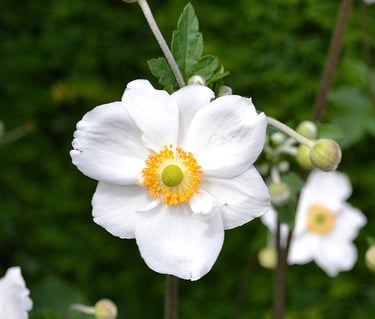

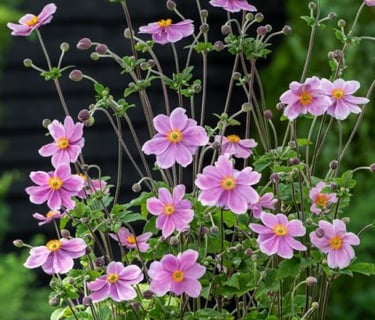

Anemone x hybrida 'Honorine Jobert'
Anemone x hybrida 'Lorely'
A word of warning – plant them somewhere that they have room to spread, once established they can spread rapidly via their suckering shoots and can be hard to eradicate; they can resurface the following year from fragments of root left behind.
Height: 0.6m - 1.2m.
Spread: 0.7m
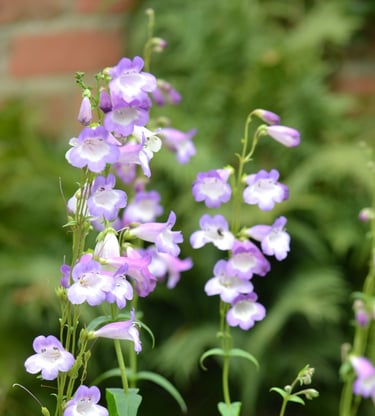

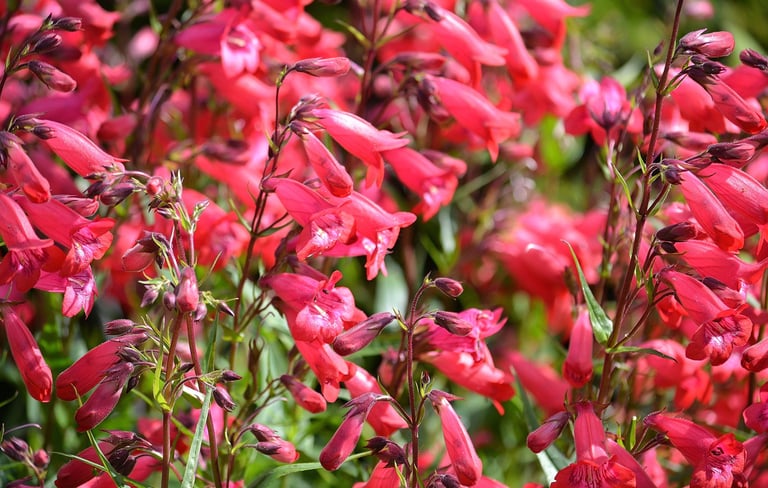

Height: 0.6m - 1.2m.
Spread: 0.7m
Penstemon 'Alice Hindley'
Penstemon 'Garnet'
These upright, bushy plants with semi-evergreen winter foliage have spires of trumpet-like flowers. The colours range from white, through pink, red, blue and purple, and some varieties are bicolour.
Penstemons do best in free draining soils, in full sun. They do not like heavy wet soils in winter, and they will not flower well in the shade. In colder areas, they can be grown near a warm sunny wall.
Leave plants over winter before cutting back in spring. Deadhead spent blooms to prolong flowering.
They're tolerant of dry conditions providing it doesn’t become too dry. They are reasonably hardy some are H3 but most are H4 and a few even H5 (Garnet). In colder areas or if planted in wetter soil it is advisable to take cuttings just in case, which you can then overwinter.
Verbena bonariensis (vervain)
These sparse wiry plants up to 2m tall are perfect for bringing stature to the border. Tough and drought tolerant, they flower from early summer to late autumn.
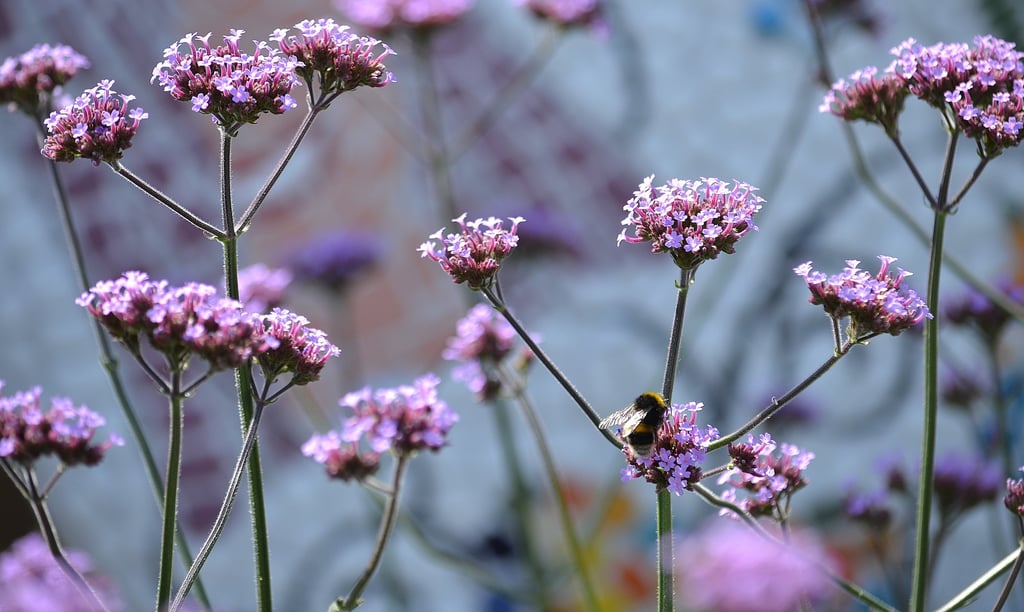

Verbena bonariensis have stiff upright branching square stems topped by tight clusters small bright blue-purple flowers. These are a brilliant nectar source for pollinating insects lasting into the autumn.
With their height and sparse leaves they have a light airy see-through structure so they can be placed anywhere in a border. They combine well with grasses and can also help support other plants. Fitting equally well into a relaxed cottage garden or into more contemporary planting themes. They are often used in Prairie planting schemes (the New Perennial Movement popularised by Piet Oudolf and Noel Kingsbury).
Verbena bonariensis thrive in a warm, sheltered spot in full sun, in any reasonably fertile free draining soil. When happy they will self-seed. They are drought tolerant and should only need watering in excessively dry periods. They are not very hardy but should survive in most of the UK, what they don’t like is the cold and wet. They can be protected with a dry straw mulch in colder, wetter areas.
They can be propagated by cuttings or seed. Because of their tendency to self-seed you could pot on seedlings and overwinter them in a cold frame.
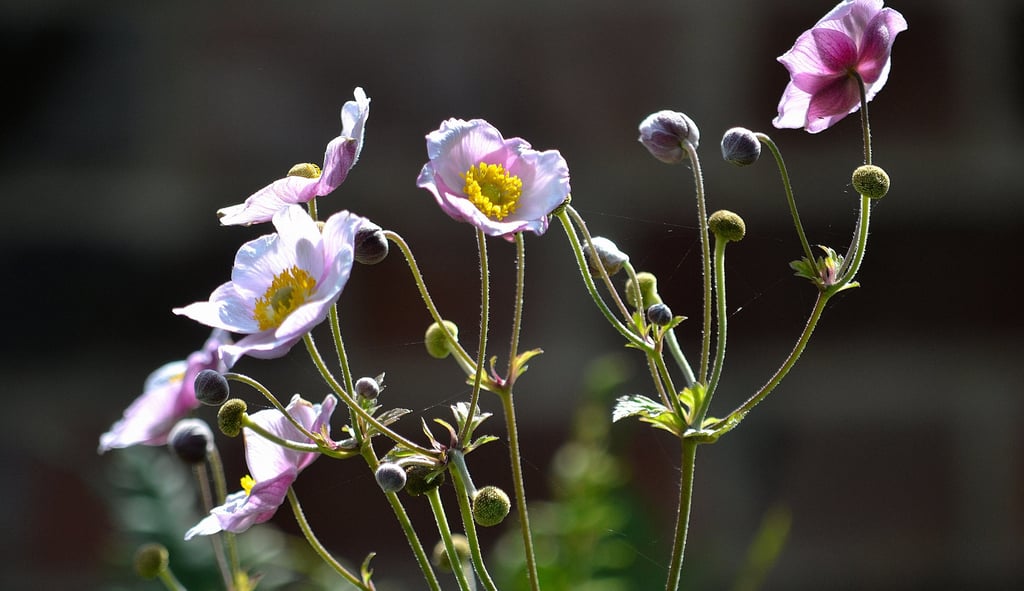

Hardiness rating:
H7 USDA Zone 5/6 (Down to -20°C)
Hardiness rating:
The most tender are H3 (Down to -5°C) USDA Zone 10
More hardy varieties are H4/H5 (Down to -10°C) USDA Zone 7-8
They come in a range of warm hues of yellow, orange or red. Their large daisy-like flowers, often with a chocolatey brown central cone are loved by pollinators for their nectar. Even after flowering their seedheads are attractive throughout the autumn. They combine particularly well with grasses and other late-flowering perennials in prairie-style planting schemes.
Position them in plenty of sun to guarantee a good show of flowers into late summer. They are happy in most fertile but well-drained soils which don’t become too parched in the summer or waterlogged in winter.
Heleniums need regular watering to prevent the soil from drying out. Deadhead the spent blooms frequently to keep the flowers coming. They die back over winter, so cut them to ground level in late autumn.
Taller varieties benefit from being supported early in the season to prevent them from flopping.
Clumps can become a bit congested after a few years, so will need dividing in autumn or spring.
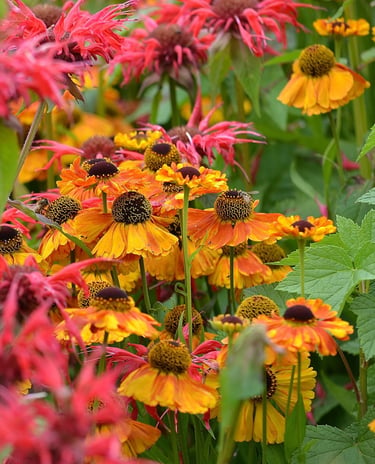

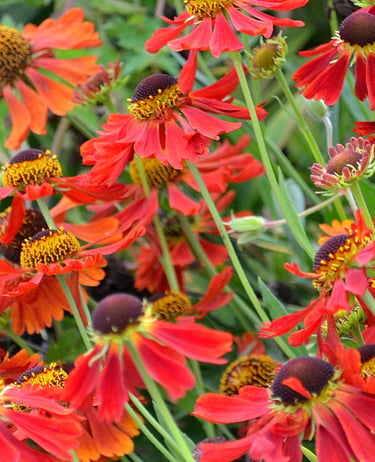

Size
Height: 0.5m - 1.5m.
Spread: 0.2m - 0.5m
Hardiness rating:
H7 USDA Zone 5/6 (Down to -20°C)
Hardiness rating:
H3 to H4 USDA Zone 9/10 (Down to -5°C)
Size
Height: 1.5m - 2.5m.
Spread: 0.2m - 0.5m
Size
Height: 0.5m - 1m.
Spread: 0.2m - 0.5m
Hardiness rating:
H7 USDA Zone 5/6 (Down to -20°C)
Aster × frikartii is a hybrid of A. amellus × A. thomsonii by the Swiss botanist Carl Frikart, first created about 100 years ago. They are less prone to powdery mildew than some of the non-hybridised varieties.
Grow them in well-drained, moderately fertile soil in an open uncongested and sunny position.
Cut back the old stems close to the ground in early spring, leaving the seed-heads and tangled foliage over the winter as these are of benefit to wildlife.
They can be propagated in spring by division or by taking basal root cuttings.
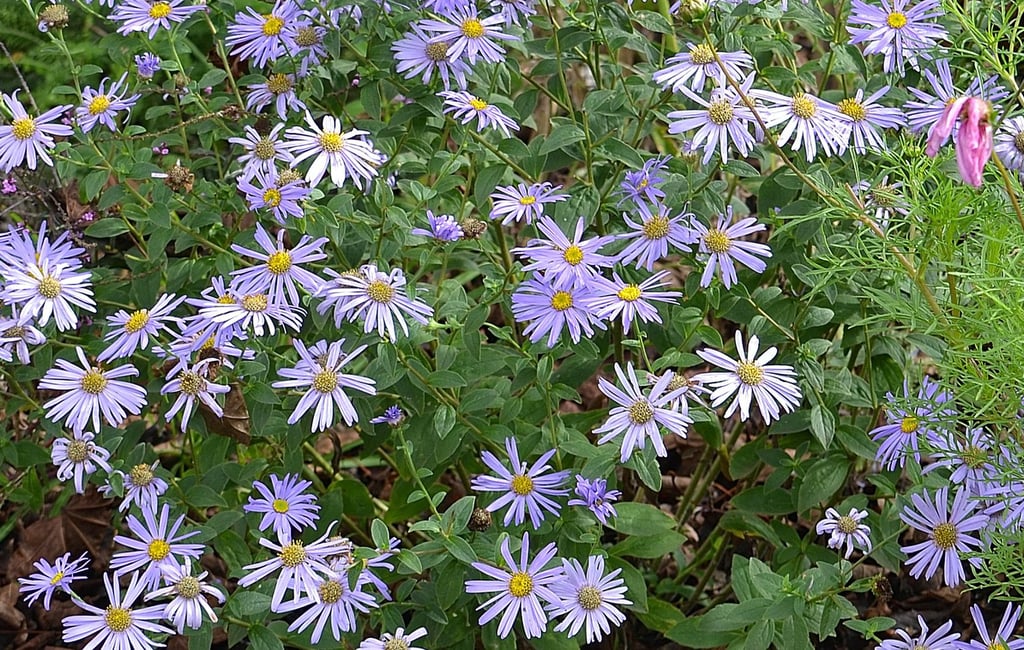

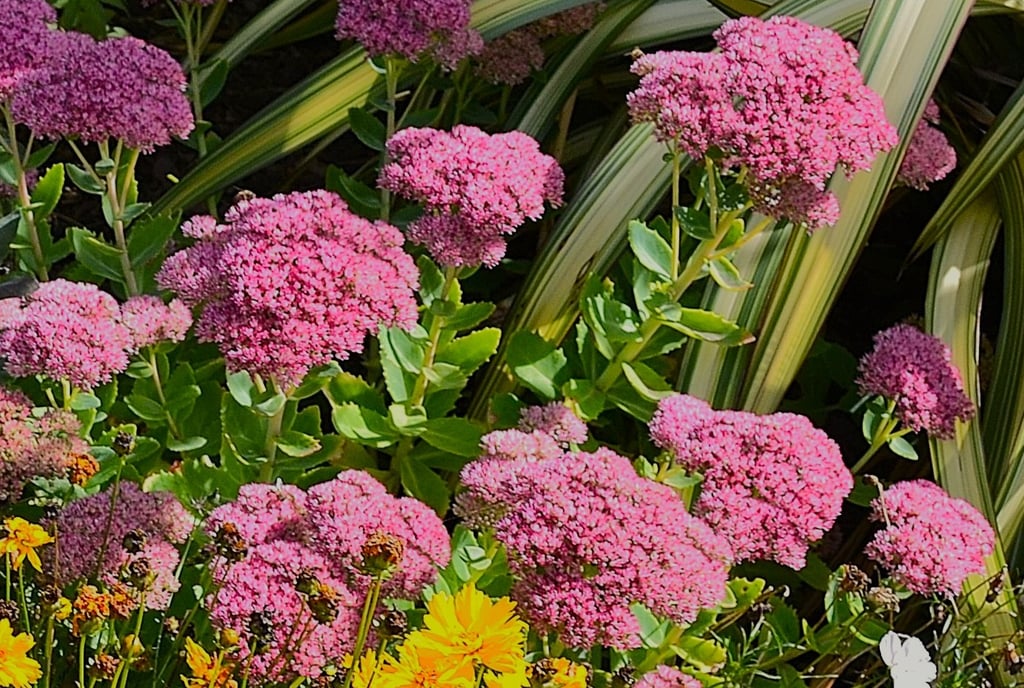

Size
Height: 0.3m - 0.6m.
Spread: 0.2m - 0.5m
Hardiness rating:
H7 USDA Zone 5/6 (Down to -20°C)
Hylotelephium, which were previously called Sedum, are clump forming herbaceous perennials. With thick upright stems and colourful, succulent leaves in spring which blossom into masses of long-lasting flower clusters up to 15cm across in late summer and autumn. They provide a colourful late season display much appreciated by butterflies and bees.
Hylotelephium spectabile have dark pink flower heads on 0.5m tall stems., They can be used in a range of garden styles from informal cottage through wildlife, dry, gravel, contemporary or Mediterranean.
They prefer well drained light neutral to alkaline soil in full sun and once established are drought tolerant. If grown in overly fertile soil they tend to collapse messily from their centre.
Cut the dead stems back to the ground in spring, as succulent new growth starts to emerge from the basal crown.
Hylotelephiums are easily propagated by division; lift and divide the clump in spring. Alternatively take cuttings taken from non-flowering shoots in early summer. In late winter you may also find rooted shoots at the bases of the stems which easily detach from the parent plant. These can be planted out to form new clumps.
Hylotelephium spectabile

